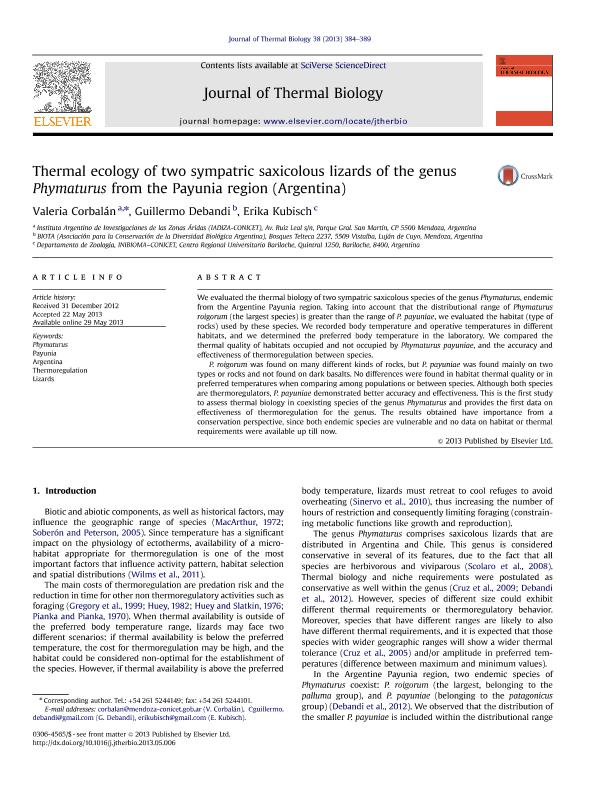Mostrar el registro sencillo del ítem
dc.contributor.author
Corbalán, Valeria Elizabeth

dc.contributor.author
Debandi, Guillermo

dc.contributor.author
Kubisch, Erika Leticia

dc.date.available
2015-07-23T13:02:58Z
dc.date.issued
2013-05
dc.identifier.citation
Corbalán, Valeria Elizabeth; Debandi, Guillermo; Kubisch, Erika Leticia; Thermal ecology of two sympatric saxicolous lizards of the genus Phymaturus from the Payunia region (Argentina); Pergamon-Elsevier Science Ltd; Journal of Thermal Biology; 38; 7; 5-2013; 384-389
dc.identifier.issn
0306-4565
dc.identifier.uri
http://hdl.handle.net/11336/1420
dc.description.abstract
We evaluated the thermal biology of two sympatric saxicolous species of the genus Phymaturus, endemic from the Argentine Payunia region. Taking into account that the distributional range of P. roigorum (the largest species) is greater than the range of P. payuniae, we evaluated the habitat (type of rocks) used by these species. We recorded body temperature and operative temperatures in different habitats, and we determined the preferred body temperature in the laboratory. We compared the thermal quality of habitats occupied and not occupied by P. payuniae, and the accuracy and effectiveness of thermoregulation between species. Phymaturus roigorum was found on many different kinds of rocks, but P. payuniae was found mainly on two types or rocks and not found on dark basalts. No differences were found in habitat thermal quality or in preferred temperatures when comparing among populations or between species. Although both species are thermoregulators, Phymaturus payuniae demonstrated better accuracy and effectiveness. This is the first study to assess thermal biology in coexisting species of the genus Phymaturus and provides the first data on effectiveness of thermoregulation for the genus. The results obtained have importance from a conservation perspective, since both endemic species are vulnerable and no data on habitat or thermal requirements were available up till now.
dc.format
application/pdf
dc.language.iso
eng
dc.publisher
Pergamon-Elsevier Science Ltd

dc.rights
info:eu-repo/semantics/openAccess
dc.rights.uri
https://creativecommons.org/licenses/by-nc-sa/2.5/ar/
dc.subject
ARGENTINA
dc.subject
LIZARDS
dc.subject
PAYUNIA
dc.subject
PHYMATURUS
dc.subject
THERMOREGULATION
dc.subject.classification
Ecología

dc.subject.classification
Ciencias Biológicas

dc.subject.classification
CIENCIAS NATURALES Y EXACTAS

dc.title
Thermal ecology of two sympatric saxicolous lizards of the genus Phymaturus from the Payunia region (Argentina)
dc.type
info:eu-repo/semantics/article
dc.type
info:ar-repo/semantics/artículo
dc.type
info:eu-repo/semantics/publishedVersion
dc.date.updated
2016-03-30 10:35:44.97925-03
dc.journal.volume
38
dc.journal.number
7
dc.journal.pagination
384-389
dc.journal.pais
Estados Unidos

dc.description.fil
Fil: Corbalán, Valeria Elizabeth. Consejo Nacional de Investigaciones Científicas y Técnicas. Centro Científico Tecnológico Conicet - Mendoza. Instituto Argentino de Investigaciones de las Zonas Áridas. Provincia de Mendoza. Instituto Argentino de Investigaciones de las Zonas Áridas. Universidad Nacional de Cuyo. Instituto Argentino de Investigaciones de las Zonas Áridas; Argentina
dc.description.fil
Fil: Debandi, Guillermo. No especifíca;
dc.description.fil
Fil: Kubisch, Erika Leticia. Consejo Nacional de Investigaciones Científicas y Técnicas. Centro Científico Tecnológico Conicet - Patagonia Norte. Instituto de Investigaciones en Biodiversidad y Medioambiente. Universidad Nacional del Comahue. Centro Regional Universidad Bariloche. Instituto de Investigaciones en Biodiversidad y Medioambiente; Argentina
dc.journal.title
Journal of Thermal Biology

dc.relation.alternativeid
info:eu-repo/semantics/altIdentifier/url/https://www.sciencedirect.com/science/article/abs/pii/S0306456513000727
dc.relation.alternativeid
info:eu-repo/semantics/altIdentifier/doi/http://dx.doi.org/10.1016/j.jtherbio.2013.05.006
Archivos asociados
